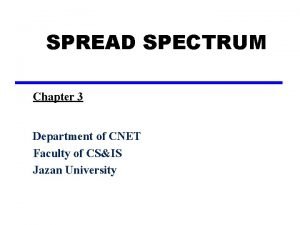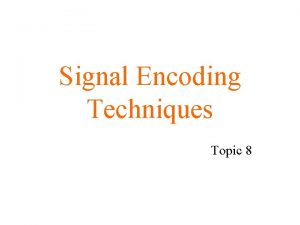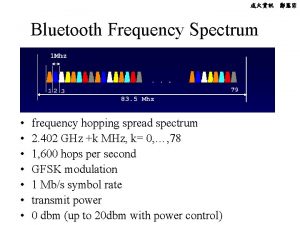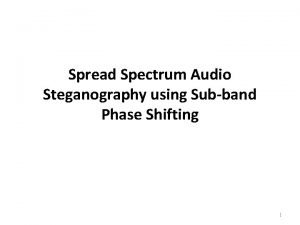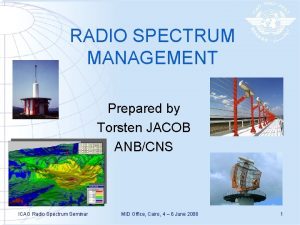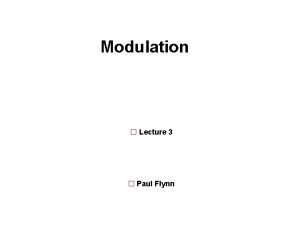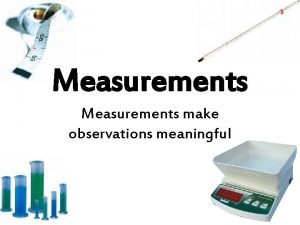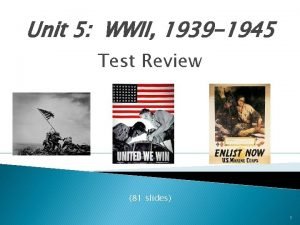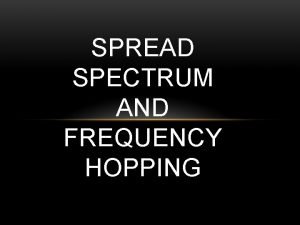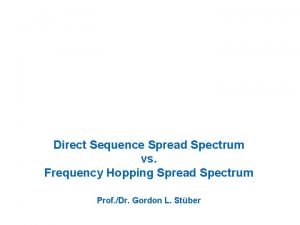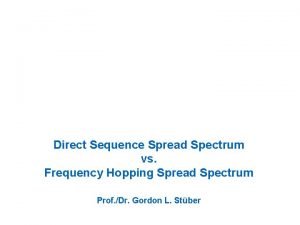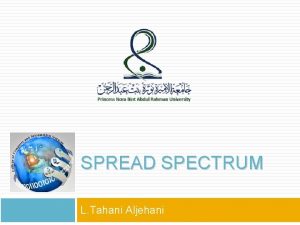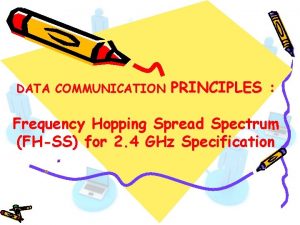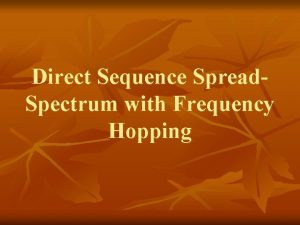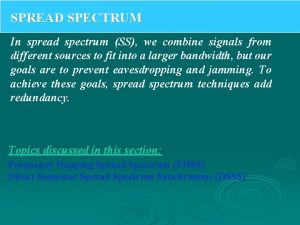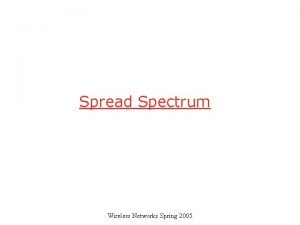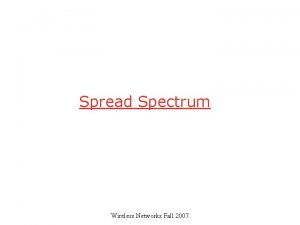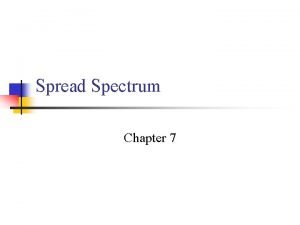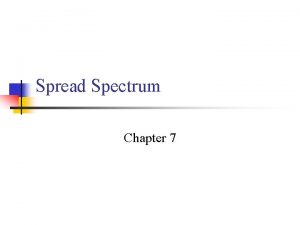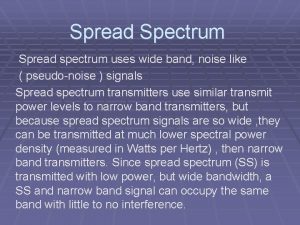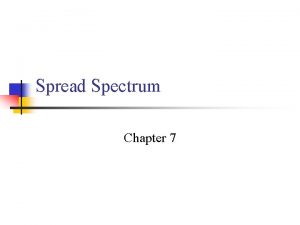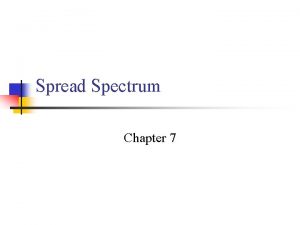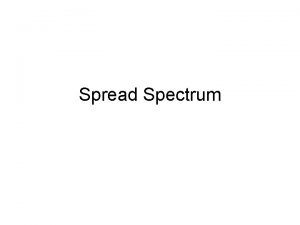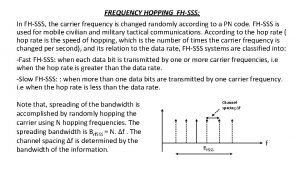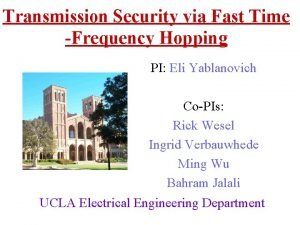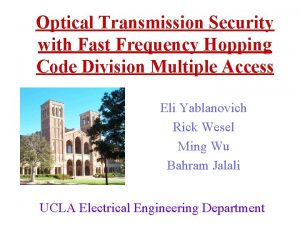A FREQUENCY HOPPING SPREAD SPECTRUM TRANSMISSION SCHEME FOR






















- Slides: 22

A FREQUENCY HOPPING SPREAD SPECTRUM TRANSMISSION SCHEME FOR UNCOORDINATED COGNITIVE RADIOS Xiaohua (Edward) Li and Juite Hwu Department of Electrical and Computer Engineering State University of New York at Binghamton {xli, jhuw 1}@binghamton. edu http: //ucesp. ws. binghamton. edu/~xli

Contents 1. Introduction 2. System model 3. New FHSS transmission for cognitive radios 4. Demodulation and Performance analysis 5. Simulations 6. Conclusions

1. Introduction n Cognitive radios (CRs) n n n A major issue: “Chicken-and-Egg Problem” n n n Detect and utilize spectrum white spaces Should avoid interfering primary users CRs are initially not synchronized (e. g. , in picking spectrum) for transmission Transmission is required to negotiate such synchronization Our goal n Develop a transmission scheme for uncoordinated CRs, tolerable to spectrum/channel uncertainty and spectrum sensing errors

Introduction (cont’) n Basic idea: Frequency-hopping over uncertain spectrum slots n n CR transmitters and receivers hop over available spectrum slots Hopping pattern determined by: n n n Spreading codes (shared) Spectrum detection results (independent) Channel selection rules (shared)

Introduction (cont’) n Assumptions n CR transmitters and receivers do have n n Some common spreading codes A common channel selection rule Common procedure of adapting transmission parameters, such as symbol rate, modulations, etc CR transmitters and receivers do not n have common spectrum white space information

2. System model n Spectrum slots for frequency hopping n n n Divide the spectrum into I segments Divide each segment into J frequency bands Each band is a basic slot for frequency hopping, which we call “channel” n CR transmitters and receivers know slot structure, but do not know which slot is available in each time

2. System Model n Major problem n n A channel may be available to a transmitter but unavailable to a receiver Define parameters:

2. System Model Segmentation-based spectrum detection: When the CR transmits in a channel, it also collects information about the channels of next segment.

3. New FHSS transmission n Spreading n n n To transmit a sequence Each symbol spreaded into M chips This procedure is identical to CR transmitters and receivers

n Spectrum slot selection n n Each chip is to be transmitted via a channel of ith segment Fi Transmitters and receivers use a common binary sequence cn to determine channel selectability in this segment

n Channel selection rule n n There may be many channels selectable in each segment Each CR Tx or Rx needs to select one channel to transmit or receive Distributed channel selection means Tx and Rx may choose different channels synchronization problem Smart channel selection rule can alleviate this problem n n n A simple rule: choose the first available channel of this segment Secondary transmitter use fi, j 1 if ui, j 1=1 Secondary receiver use fi, j 2 if wi, j 2=1

n Successful transmission→ Tx and Rx selected the same channel, i. e. , j 1=j 2

Illustration of multiple CR transmissions using our scheme

4. FHSS demodulation and performance analysis n FHSS/MFSK demodulation n Vector symbol model for FHSS/MFSK signals

n FHSS/MFSK received signal model Baseband channel matrix Frequency slot synchronization indicator function

n Demodulations: coherent demodulation Element-wise description Coherent: Maximum Likelihood detection n Demodulations: non-coherent demodulation

4. FHSS demodulation and performance analysis n Performance analysis n n Major issue: Tx and Rx may use difference frequency slots channel mismatch SNR for coherent demodulation

n Performance is limited by the correctness of frequency-selection n n Assume mismatch probability pd be the probability that there is mismatch in the first j channels With our simple channel selection rule

n Average channel mismatch probability n For every M transmissions, number of correct matches

5. Simulations Spreading gain M=40 Symbol amount K=100 Segments I=20 J=100 channels/segment

5. Simulation Mismatch pd≒ 0. 1 Symbol amount K=100 Segments I=20 J=100 channels/segment

6. Conclusions n Developed an FHSS-FSK transmission scheme for uncoordinated cognitive radios n n n Tolerate spectrum sensing errors No need of coordination assumptions Use FHSS spreading gain to combat spectrum sensing errors and to avoid interfering primary users Resolve the “chicken-and-egg” problem: provide a way for CRs to initiate communications in uncertain spectrum Simulations demonstrate reliable performance even in large spectrum sensing errors
 Frequency hopping spread spectrum
Frequency hopping spread spectrum Frequency-hopping spread spectrum
Frequency-hopping spread spectrum Bluetooth frequency hopping
Bluetooth frequency hopping Src spread spectrum
Src spread spectrum How to spread cold butter
How to spread cold butter Orbital description
Orbital description Absorption spectrum vs emission spectrum
Absorption spectrum vs emission spectrum The spectrum bent into a circle
The spectrum bent into a circle Elwctromagnetic spectrum
Elwctromagnetic spectrum Frequency spectrum chart
Frequency spectrum chart Frequency spectrum
Frequency spectrum Who was the mastermind of the island-hopping strategy
Who was the mastermind of the island-hopping strategy Guest hopping attack
Guest hopping attack Kangaroos hopping down mountains
Kangaroos hopping down mountains Who was the mastermind of the island hopping strategy
Who was the mastermind of the island hopping strategy Island hopping
Island hopping Andy hopping
Andy hopping Leapfrogging island hopping
Leapfrogging island hopping Ending the war on fat
Ending the war on fat What is vlan hopping
What is vlan hopping Bopping them on the head
Bopping them on the head Island hopping
Island hopping Kangaroos hopping down mountains
Kangaroos hopping down mountains
